Today we offer a photo post. All of these photographs were taken in the past week and offer a snapshot of spring. All photos by J.Harding

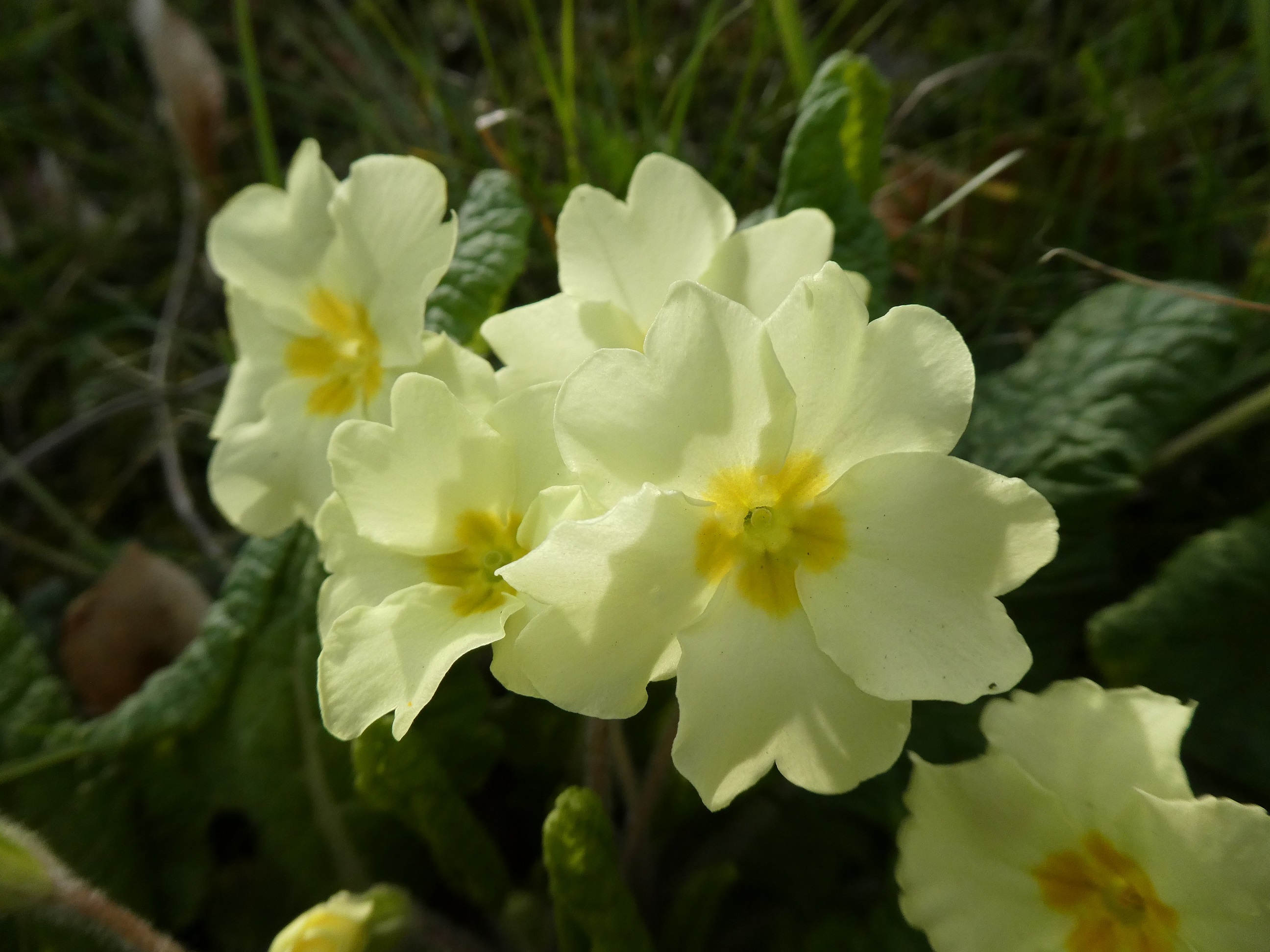


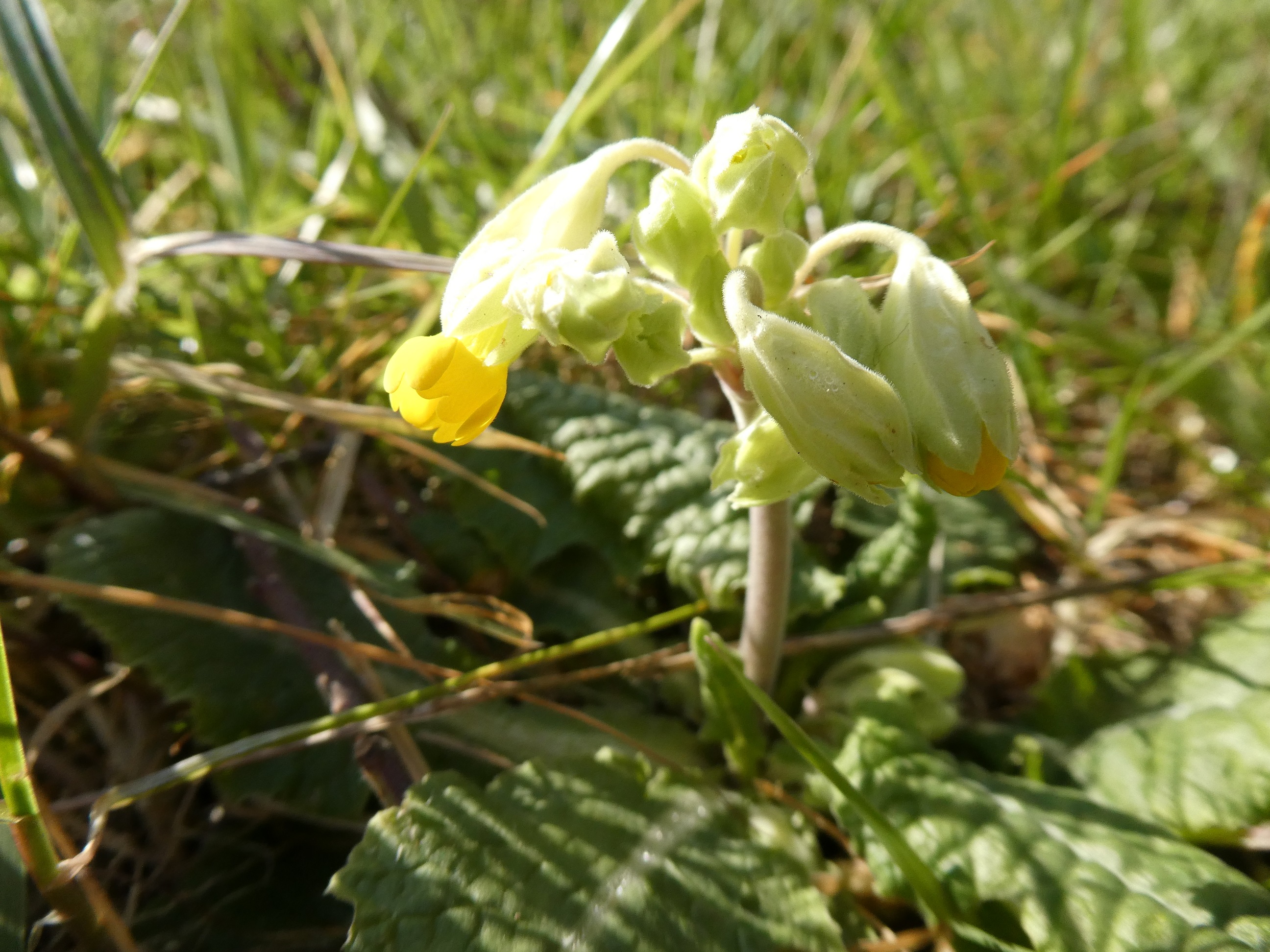

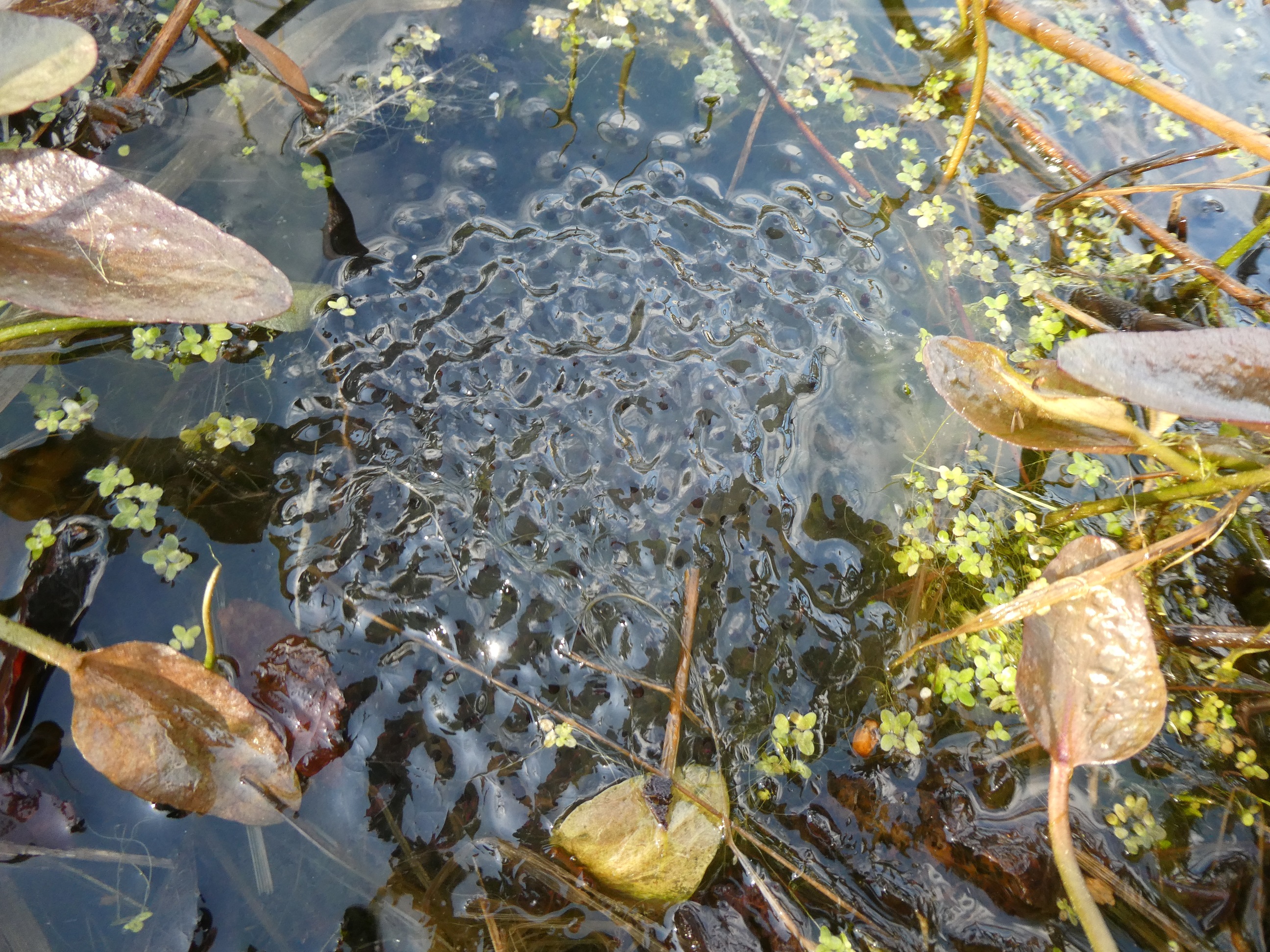
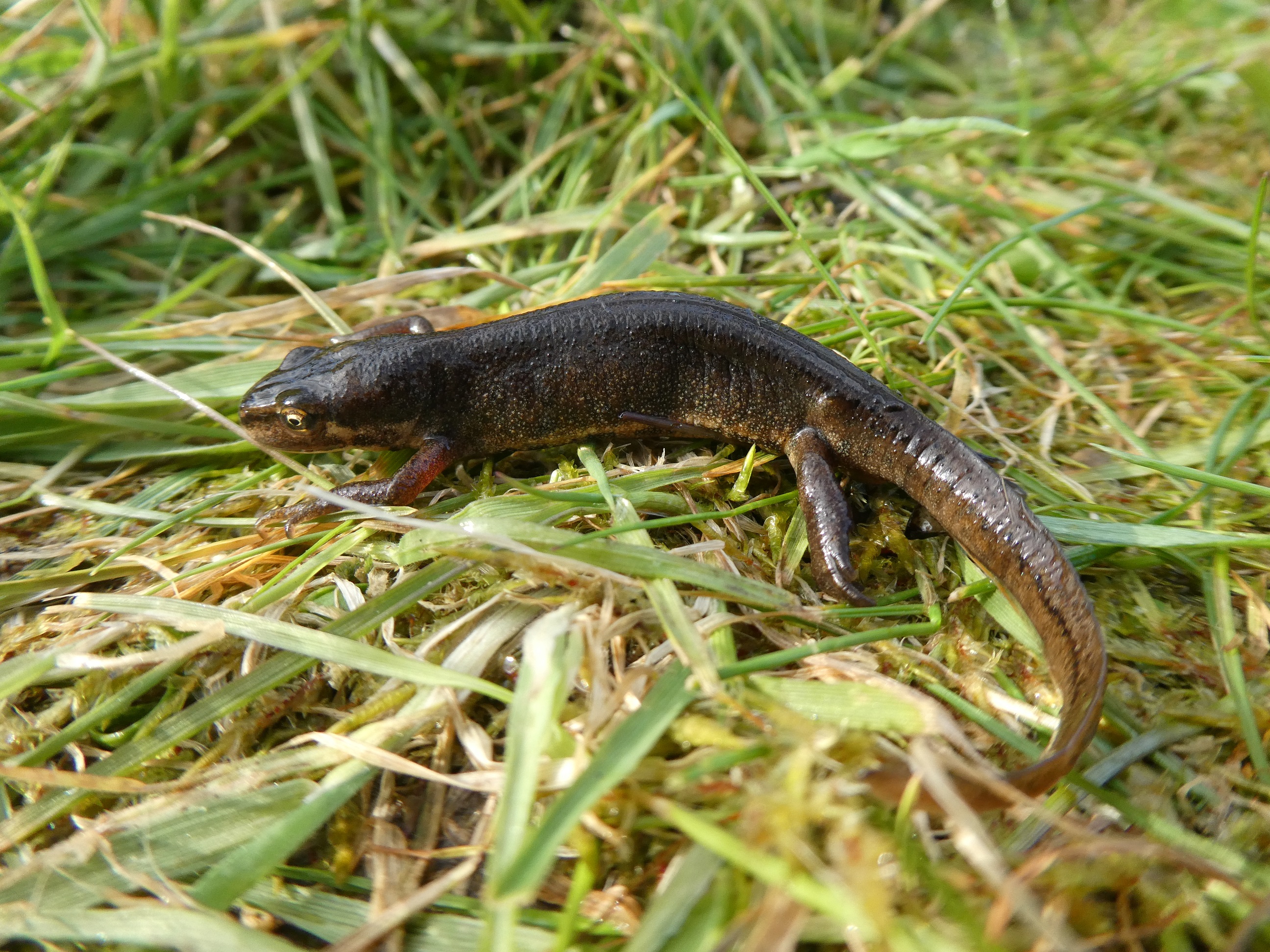


Irish Butterfly Website
Today we offer a photo post. All of these photographs were taken in the past week and offer a snapshot of spring. All photos by J.Harding








In 1658 the word ‘butterfly’ in its modern English form appeared in the work of Thomas Moffet (1553-1604) as translated into English in that year. At his time the renaissance spirit infused Elizabethan England causing some to look at the natural world with a great deal more interest and curiosity than before. Go forward a half-century and onwards after Elizabeth II’s reign ended in 1603 and there were more gentlemen collecting and studying butterflies. These included John Ray 1627-1705, Joseph Dandridge 1664-1746, James Petiver 1663-1718 and William Vernon 1660-c.1735.
However, only one of the Lepidoptera pioneers had a butterfly named after him, or to be correct, her.
Eleanor Glanville was born in Yorkshire in about 1654, the daughter of Richard and Muriel Goodricke, the cultivators of the Ribston Pippin apple. From her parents, Eleanor inherited considerable property, including Tickenham Court, Somerset, where she later lived.
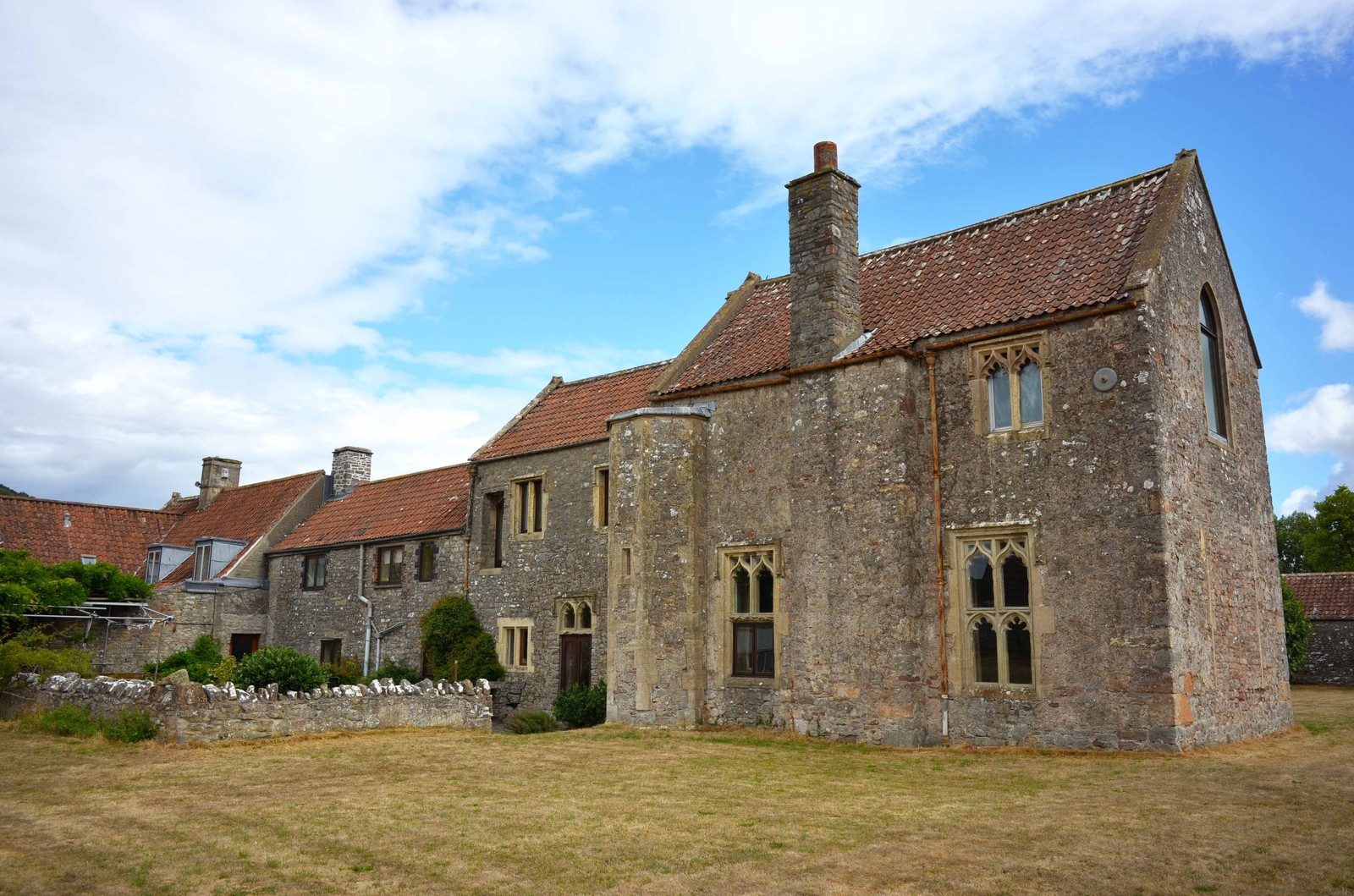
Eleanor’s interest in insects seems to have begun after the demise of her second marriage to Richard Glanville who once held a loaded pistol “to her breast” and threatened to shoot her dead. Glanville wrote to other entomologists, such as Ray, Vernon, Dandridge among others. She sent cases of specimens to her correspondents among them a fritillary she caught in Lincolnshire in about 1702. This specimen was used by the great Swedish scientist, Linnaeus to describe the insect for science. This was first called the Lincolnshire Fritillary.
Eleanor reared butterflies and moths, including Green-veined White and High Brown Fritillary. She collected caterpillars from hedging by placing a sheet under the hedge and beating the shrubbery with a long pole, much to the amazement of a witness, John Brewton, who described how Eleanor and two girls performed the operation to “catch a parcel of worms”. Eleanor did not seem to know how to protect her collection; mites did much damage. However, three of her specimens, a butterfly and two moths, have been re-found in the Sloane Collection in the Naural History Museum, London. (Hans Sloane, 16 April 1660 – 11 January 1753 was born in the charming village of Killyleagh, County Down where a statue commemorating him stands. From an Ulster-Scots family, Sloane donated 71,000 items he collected to Britain).
The turbulent private life of Eleanor Glanville was reflected in what happened after she died. Sadly, her interest in butterflies was used to damage her reputation. Her estranged husband, eager to get her property, planned to kidnap one of her sons and persuade the boy to transfer his interest in the property to him and his new mistress. Aware of her husband’s plot, Eleanor arranged to leave her property in the care of trustees. She left her property mainly to Sir Henry Goodricke, her second cousin.
However, her will was challenged by Eleanor’s eldest son, Forest. He contended that the will be set aside on the grounds that his mother was insane and believed her children had been changed into fairies. That was advanced as the reason that she acted unnaturally in not leaving her property to her own children.
The evidence produced at Wells Assizes in 1712 involved 100 witnesses. Either Petiver or Sloane appeared as a character witness. Villagers testified for the plaintiff, describing Eleanor’s eccentric behaviour. The court found for the plaintiff, no one “not deprived of their senses should go in pursuit of Butterflyes”. Her will was set aside. Eleanor Glanville was effectively declared insane.
There is a happy ending of sorts. By the time she had been dead forty years, the accepted name of the fritillary Eleanor discovered in Lincolnshire bore her name. It still does; the Glanville Fritillary.
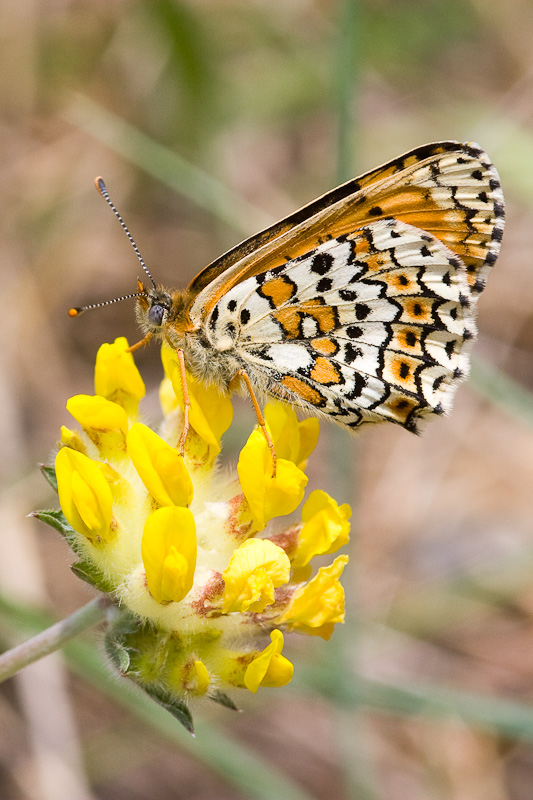
The Small Tortoiseshell is probably one of the most-loved butterflies in its vast European and Asiatic range. Apart from its beautiful patterning and colouring, it seems to like us, endearing us to it. The butterfly likes to visit our gardens, likes the flowers we plant, is quite tame allowing us to take a snap, the caterpillars eat nettles, helping to control this plant. And to top it off, they’ll even move in for the winter without causing us the slightest trouble. In fact, our guest stirs our desires to care for nature, a very positive feeling we can all do with. We admire the butterfly’s fortitude and staying power, going months without a sip of nourishment only to surge into the spring sunshine. What’s not to like about the Small Tortoiseshell?
And it is with us as an adult for almost the whole year. It is admittedly scarcer in June and in some years during mid-August when it is mainly found in the immature stages but this gap is short. It flies in the open from March-May and July and August-October.
The butterfly can produce a number of generations in a year. In colder parts of its range, such as Lapland, and at high altitudes it produces just one brood (univoltine) but, in warmer localities, it can fit in three generations (trivoltine). In Ireland, it is mainly double-brooded (bivoltine) but there are years when a small third generation is produced. The butterfly typically breeds in May/June and July when the gregarious larvae are found in warm nettle beds. In some years, larvae are found in September, the third generation.
From observations made in Ireland, the following brood structure appears to exist: a full first brood flying from late June throughout much of July (this generation results from the previous year’s butterflies that over-wintered). A second brood flies in August and some of September before entering hibernation. A small third brood flies in late September and in October which also enters hibernation. However, a small number of first-generation butterflies, which hatch from their pupae in June/July appear not to breed the year they emerge. These feed up for a few weeks in July and early August before entering hibernation. This brood pattern will vary according to weather conditions in a particular year. Latitude does not appear to influence brood structure in Ireland-there is evidence from Donegal that there are two generations in the majority of years and a third flight in the warmest years in the south of the county (Aldwell and Smyth 2016).
Lost Generation
However, a study carried out in Hertfordshire, the county adjoining and north of London, may foreshadow what might occur here in future. The study carried out in a shed in St Albans, monitored the dates that Peacock and Small Tortoiseshell entered and left hibernation in 2016, 2017 and 2018 with the figures for butterflies seen in flight over two periods, 2000-2009 and 2016-2018 (https://butterfly-conservation.org/news-and-blog/small-tortoiseshell-the-lost-generation).
The results are extremely interesting and highlight the butterfly’s adaptability. But they might also foreshadow a less desirable development.
In 2017 all the Small Tortoiseshells were hibernating by 7th July. In 2018 hibernation was complete by 5th August. But in 2016 the last five did not enter hibernation until mid-October.
The figures for butterflies seen in flight in 2017 and 2018 tally with the hibernation statistics; there was little or no evidence of a second generation in 2017 and 2018. But there was a very obvious second brood in 2016.
What’s Happening?
I was in the south of England in the second half of July in 2018, when we had record-breaking high temperatures. I was visiting great sites for butterflies and many species thrived. However, I saw almost no Small Tortoiseshells, which bewildered me. On some of the highest-quality reserves, I saw no Small Tortoiseshells but I did see Peacocks.
The summer weather in 2018, hot and dry, suited adult butterflies. There were plenty of nectar sources and warm weather to make it easy to move. However, the drought must have had a serious impact on larval foodplant quality and even availability. I do not know what triggers adult Small Tortoiseshells to breed or to hibernate but foodplant quality and or very warm, dry conditions might play a role. The ecological adaptability of this remarkable butterfly makes it a success but it is saddening to think that the butterfly may become much scarcer in our gardens in the future; it is the second generation that spends so much time in our gardens in August and September.
There is some indication that this switch to one brood is happening in Ireland. Frank Smyth (co-author with Robert Aldwell of The Butterflies of Donegal) has reported that the Small Tortoiseshell has been absent from Howth in a number of years from July until spring. According to Frank, this is a change in its occurrence in the area. This highlights the crucial importance of recording butterflies.
Is there anything we can do?
If we are to experience warmer, drier summers it is likely that the butterfly’s response, to abandon its second generation and enter the overwintering stage in summer will become the species’ new strategy. Locally, there is some, admittedly limited scope for encouraging a second brood. When the first brood has pupated and the butterflies emerge, usually in late June/early July, cut the nettles and or water these heavily to encourage lush re-growth. This should make the nettles available for breeding. A very important step is to provide plenty of nectar-if the adults need to drop their second brood, these will be busy feeding to build fat reserves for winter. Because of the very long over-wintering period, it is really important that the butterflies find the nectar they need.
Finally, keep the shed door or window open during a hot, dry summer. And keep spider webs to a minimum. Your butterflies need such sites and may need to call on your hospitality for longer.
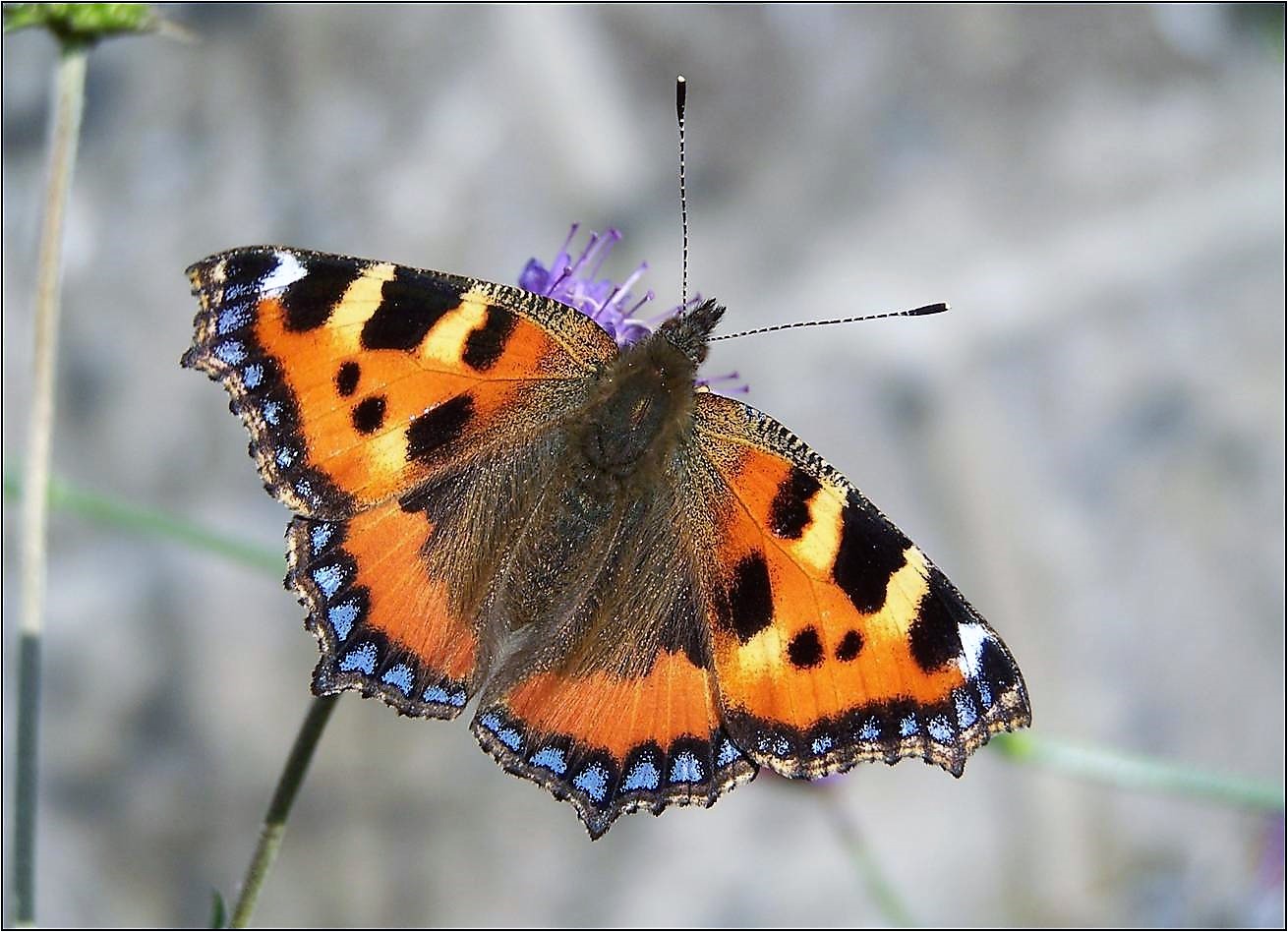
Butterfly Conservation Ireland has had an unprecedented number of inquiries over the past few months concerning how to care for Small Tortoiseshell butterflies spending the winter indoors. We responded by posting advice (for example, see February archive) and via email. Some of the inquiries came from the United Kingdom. In this article, Wendy Bernice, who lives in West Yorkshire, describes her experience of caring for a Small Tortoiseshell butterfly in her home near Huddersfield. Wendy’s article is a reminder to release your Small Tortoiseshell now (or stagger release over the next three weeks)-while conditions are sunny and settled. There are many flying wild now, getting ready to breed. Enjoy Wendy’s story.
December 28th 2019 was the date on the first photo of my Small Tortoiseshell butterfly. It first appeared clinging to the inside glass of the patio door in the lounge. As it swooped towards the lights, I started rushing frantically around switching off lights and lamps. Over the next few days, it disappeared and then kept re-appearing. What should I do? I knew nothing about butterflies and thought they only lived for a few days. I searched on the Internet for help and finally decided my small walk-in wardrobe would be the best spot to place him/her. I did not want to leave the butterfly in the garage, the fridge or the attic, I would never see it again.
I placed the butterfly in a small cardboard box and took it upstairs and left the box in my dark wardrobe. I had recently been given a gift of delicious honey straight from the beehives of French bees. Lucky butterfly in for a feast! I dissolved about half a teaspoonful of honey in a small amount of warm water and then put a cotton wool ball in the water to soak it up. I placed the cotton wool ball inside the box next to the butterfly, leaving the lid open but closing the wardrobe doors. I put a fresh cotton wool ball into the bowl every three days. It was all guesswork.
After a few days when I looked in to see how my butterfly was, it was lying at the bottom of the box and I thought it was dead. I did not try to move it immediately but left it there. A couple of days later when I looked into the box it had disappeared and then I discovered it in the bedroom sitting on the dog bed – not a good place to sit! I placed it back in the box, but over the next few days it kept escaping into the bedroom.
One day it was on my shoe, the next day on the curtains and finally in an empty dog bowl in the adjoining bathroom. I carried it carefully back into the wardrobe in the dog bowl and looked around to see how it kept escaping. There was a gap underneath the doors, so I blocked it with a small blanket which solved the problem. After blocking the light from the bottom of the doors the butterfly did not leave the dog bowl. The butterfly moved about in the bowl and fed often on the cotton wool balls. I had to go in and out of the wardrobe for clothes, bags and shoes fumbling about in the half-light so as not to disturb it and carefully replacing the blanket every time at the bottom of the doors so that the light would not attract it. This carried on until the day of release.
On Jesmond’s recommendation, the day of release finally came on a beautiful sunny day on the 25th March 2020 in Kirkheaton near Huddersfield, West Yorkshire. Happily, I carried the dog bowl to the open window. (At this point it is relevant to mention that I live in a chalet bungalow, which means there is a roof beneath my bedroom window). The ledge was not large enough for me to place the bowl on and wait for the butterfly to depart.
I thought it might go on to my finger for take-off, but when I placed my finger near, it started to panic flapping its wings. I tried to transfer it to the window ledge and to my horror it went tumbling off the ledge and down the sloping roof into the gutter and out of sight. I was paralysed with fear, was the gutter filled with water and had I foolishly sent my beautiful butterfly to its death after weeks of tender care. I stood rooted to the spot in disbelief hoping that the little butterfly would pop out above the parapet, but it did not.
What next? I went into the garage and got out the step ladders and precariously placed them on two separate steps leading from the house – a stupid and dangerous idea. I managed to reach up and put my hand in the gutter, which was nice and dry. I returned the steps to the garage. Had my butterfly survived, I needed to know. I then had an idea to attach a mirror to the end of my grass rake. I then held the rake vertically, from the ground, with the mirror attached on the top trying to look into the gutter to see if the butterfly was still there. The mirror was not very stable and kept moving. I did not think the butterfly was there, but honestly not really sure. What more could I do without injuring myself? I’m sure it survived.
I gloomily ate my lunch and then had another idea. I retrieved the step ladders from the garage and placed them firmly on the patio. I then tied the mirror back on to the rake and this time I went up the step ladder and held the rake horizontally towards the gutter, and finally, I could see along the length of the gutter which contained some soil and greenery but no butterfly. I was happy at last knowing my butterfly had survived.
I saw two Tortoiseshell butterflies flying close to each other in the garden at this time and landing on a bush together. I’d like to think, no I’m sure, that one of those butterflies was my Christmas butterfly.
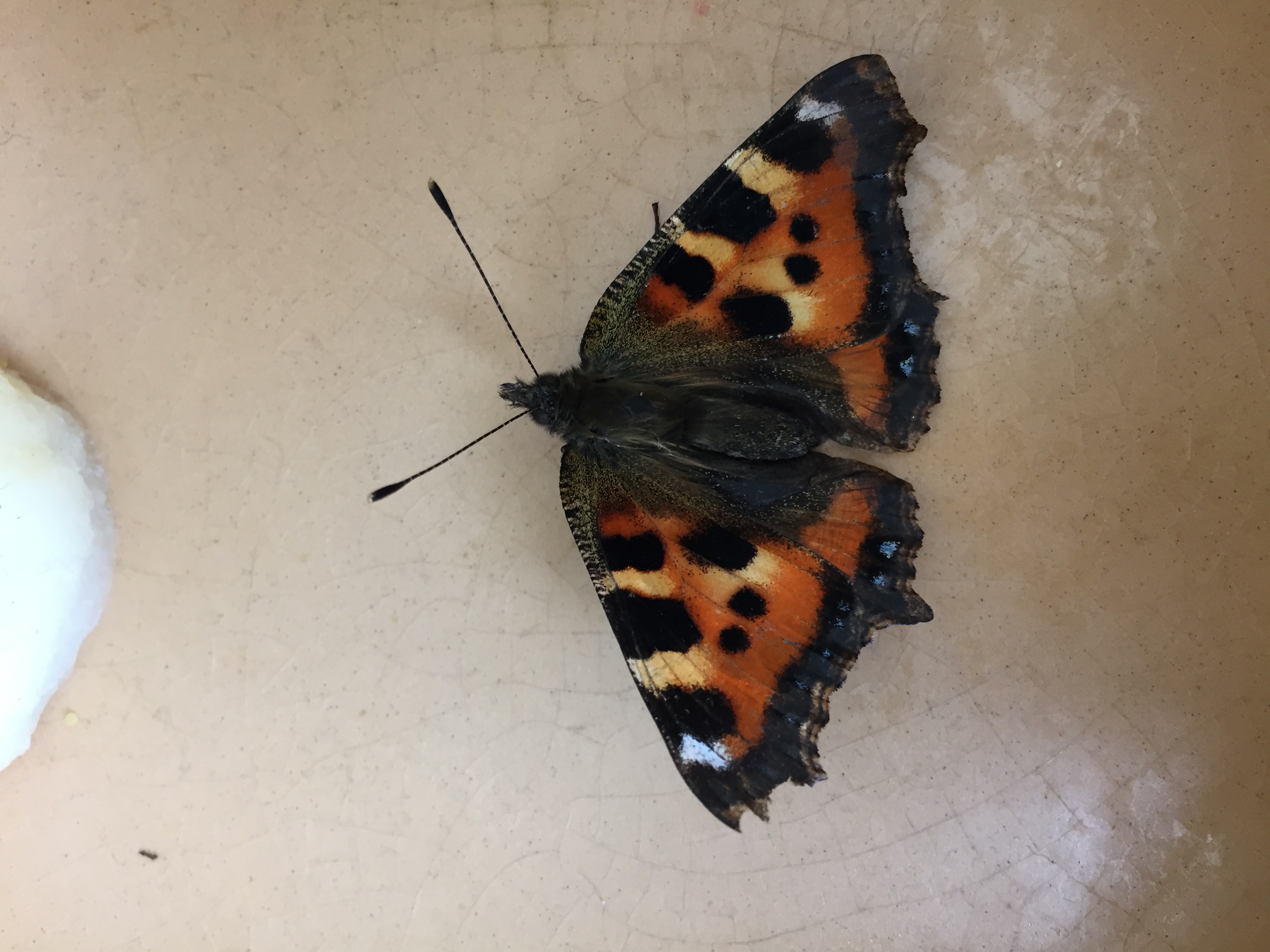

If there was ever a new phrase we’ll never forget, social distancing must be one of them. I am finding myself feeling edgy whenever I see anyone approach. I find myself lining up obediently at those yellow floor lines in Tesco. My pharmacy admits one person at a time. No bingo, no school, no library, no gym, no sport, no playgrounds, no pubs, no restaurants, no hairdressers, no, no, no.
Not great, is it? But necessary.
But it got me thinking.
Do butterflies apply social distancing? The answer is yes, especially in spring!
In late summer and autumn, the species that overwinter as adult butterflies, the Comma, Peacock, Red Admiral and Brimstone happily feed together. Some even crowd together on the same inflorescence, especially buddleia and, in the case of the Comma, on the same Ice Plant inflorescence or overripe fallen fruit.
But in spring, when their priorities are so different, their attitude is totally different.
These species’ behaviour changes. Instead of congregating in an area to feed up for winter, they disperse and range widely, especially the Peacock and Small Tortoiseshell. Indeed, the male Small Tortoiseshell, Peacock and Comma become ferociously territorial. Any other butterfly entering their patch is swiftly investigated. Females are pursued. But the ladies play hard to get, clearly keen on social distancing.
Female Small Tortoiseshells and Peacocks flee, with the male having to find a burst of pace to keep up. Female Peacocks fly round the back of a tree trunk and close their wings, their black undersides blending in with the bark. The poor male flies wildly around, looking for her.
Female Small Tortoiseshells will deliberately fly into the territory of another male leaving her pursuer and the new male to fight while she vanishes. Another tactic she uses is to drop into vegetation. Being in love is not easy for a Peacock or Small Tortoiseshell.
Territory-holding male Commas, Small Tortoiseshells and Peacocks react aggressively to males entering their land. Fierce and frequently prolonged combat takes place, with males flying steeply upward, trying to fly above their rival. The opponent sometimes drops steeply followed by the territory holder only for both butterflies to climb sharply again-a sign that the rival has not given up. Some battles are brief. The invader is repulsed. But on some sites the rivals battle on and off for hours. So intense are these encounters you can hear the clash of wings. This activity takes time away from the vital job of ‘watching the girls go by!’
Sometimes the holder drives off a rival and returns home only to find a new male has moved in!
There is one benefit for butterfly-lovers of this frenetic action. The sexes of the Peacock, Small Tortoiseshell and Comma look identical. There is one sure way of distinguishing the sexes in spring. Both sexes bask on warm, dry ground. Males do so to warm up and to be ready to pursue a mate or rival. Females bask just to warm up. If you throw a stick over a basking female, she will ignore it. A male immediately reacts, thinking he sees another butterfly. He flies upwards. You know then that you’re looking at a male.
Brimstones don’t hold territories. Males patrol a patch such as a wood edge. They are not aggressive towards other males-they see them, check to see if it is a female and lose interest when he finds a male. But like the other butterflies that pass the cold months in the adult stage, they are not friendly!
Perhaps like spring’s earliest butterflies, we can change to meet our new circumstances.
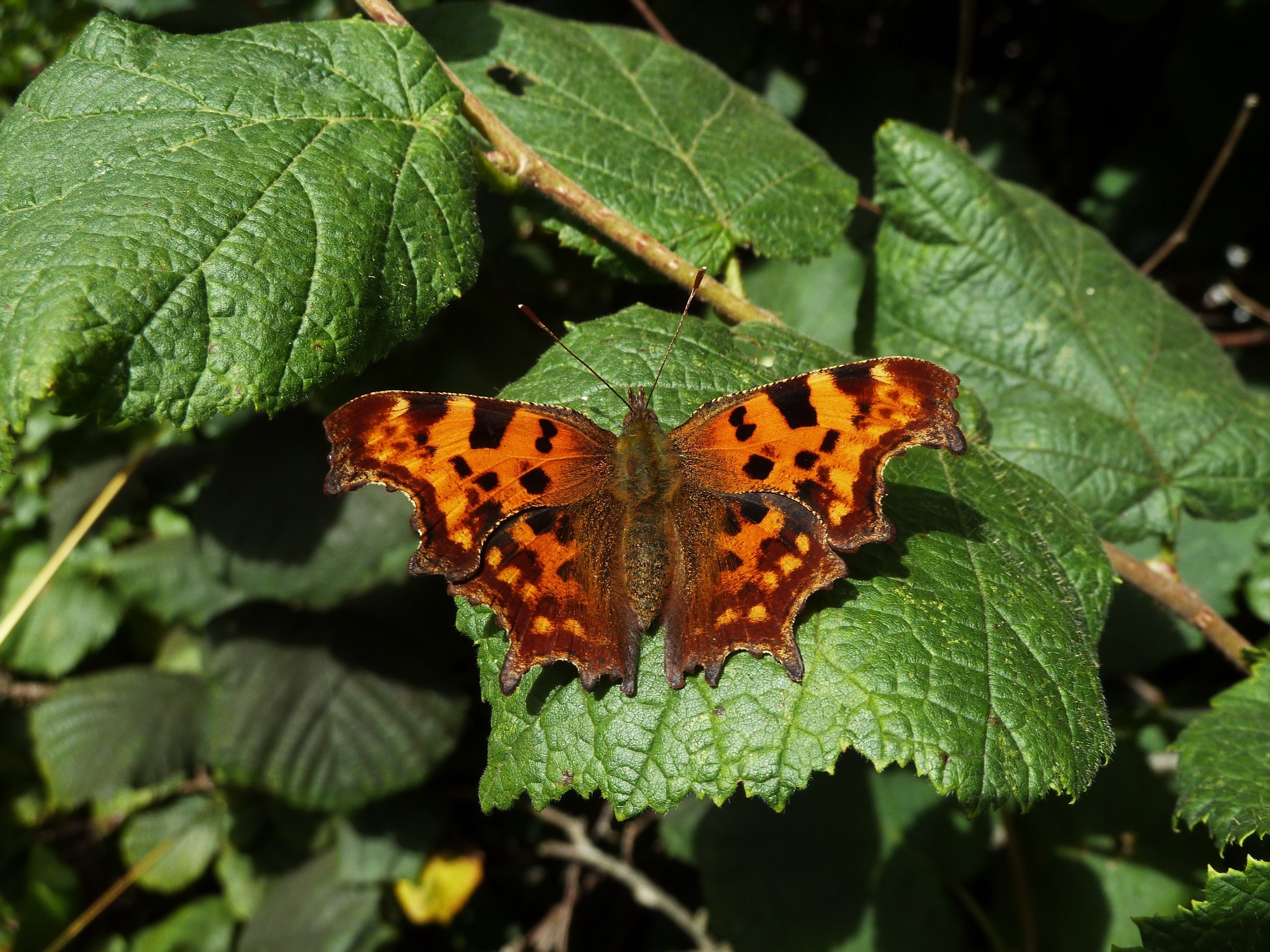
In today’s post Butterfly Conservation Ireland brings you an article by Pat Bell. Pat, based in Maynooth, gardens for nature generally and especially for butterflies. His close observation has meant that Pat has accumulated a great store of data which has allowed him to increase our knowledge of butterflies. Strangely, it is frequently common species that are often least-studied but the Small Tortoiseshell has not been neglected by scientists. It is a remarkable butterfly and has been proven to have a landscape memory. Here Pat delves into the butterfly’s generation structure, its activity requirements and into the adult’s taste in nectar.
In addition to carrying out Butterfly Conservation Ireland’s garden survey, I also count the butterflies in my garden on a weekly basis. I use a methodology similar to Birdwatch Ireland’s Garden Bird Survey in that I record the highest number of butterflies observed at any one time for each species every week. I then put these numbers into an Excel spreadsheet which enables me to generate useful tables, charts and graphs.
Almost 40% of my total abundance is Small Tortoiseshell so this is the species I have chosen to do some statistical analysis on. My first graph is a plot of the weekly counts over the Irish Butterfly Monitoring Scheme period which is conducted by the National Biodiversity Data Centre and runs from 1st April to 30th September. The graph shows clearly the two-generation structure characteristic of this butterfly. The first peak in week 17 is late July and while some go directly to hibernation most of this short-lived generation go on to produce the larger second brood that emerges from mid-August. The second peak in week 23 is early September and the main activity of these butterflies is to feed up for the long hibernation ahead.
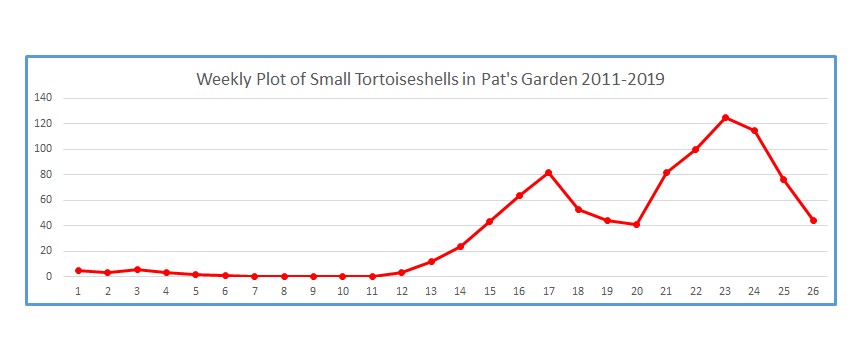
For some time I have been increasing my efforts to make my existing wildlife garden more butterfly friendly especially by focussing on nectar-rich flowers and larval food plants. My grass area (not a lawn) with wildflowers continues to evolve, I have a perennial herbaceous bed, an annual bed which I experiment with and a couple of nettle patches. I also have a small native hedgerow (yes, in a suburban garden) and about a dozen different fruit trees. A summer-flowering buddleia was planted in May 2010 and an autumn-blooming buddleia in 2011. This latter produced its greatest blossom in 2012 when I observed my record numbers of Small Tortoiseshells, maxing at 50 in week 24 around the middle of September. I never reached these numbers again and I had more or less put it down to the fact that it is difficult to keep buddleia blossom going strongly into September even the autumn flowering one.
At this point perhaps I should mention that I have a grid-connected photovoltaic solar system. This also churns out lots of data which go into another spreadsheet; I like my spreadsheets. This allows me to correlate sunshine levels and butterfly abundance. Just as our weather is very variable so are our butterfly numbers. In some years my Small Tortoiseshell numbers hold up well to the end of September, while in other years they can fall away quite suddenly and then there are just poor years. My numbers last September 2019 were average enough and tailed off gradually over the month. When the butterfly season is over I get to play around with the numbers.
I thought I detected something interesting which I put to the test, Pearson’s correlation coefficient R to be specific. This is easy enough to do in Excel and I was pleasantly surprised to get the result I did of R=0.87 which is quite a strong correlation. The trendline graph below generated by Excel shows clearly the close relationship between the output from my solar system and numbers of Small Tortoiseshells in September, the high point on the right of the graph is from the aforementioned 2012. R²=0.76 is the variance and can be interpreted as 76% of the variation in Small Tortoiseshell numbers can be explained by sunshine levels in my garden.
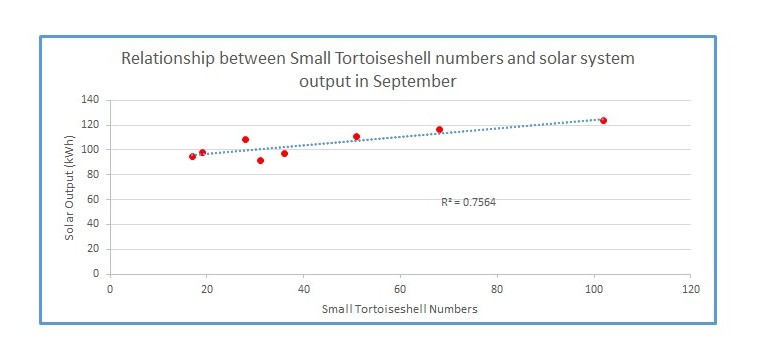
As a further test I then correlated my Small Tortoiseshell numbers against hours of sunshine in September from Met Éireann’s weather station at Casement Aerodrome which gave virtually a zero correlation. I have interpreted this to mean that Small Tortoiseshells react to the micro sunshine conditions in my garden. While this may not be entirely surprising there are other factors which can influence butterfly numbers such as food availability, cyclical variability and natural predation and parasitism and I did think originally that their numbers were just linked to the availability of buddleia blossom. Small Tortoiseshells often travel up to several kilometres each day so perhaps they are lured to my garden by the scent of the buddleia when flying conditions are favourable.
I won’t be doing a PhD on this but it keeps me amused and I hope it is of some interest to readers in these difficult times.
Pat Bell, March 2020
The following photographs, all © Pat Bell, indicate one reason why the Small Tortoiseshell is so successful; it is able to exploit a range of nectar sources. Not all species can do this; the Hedge Brown is limited to flowers with a shallow flower tube to access the nectar.

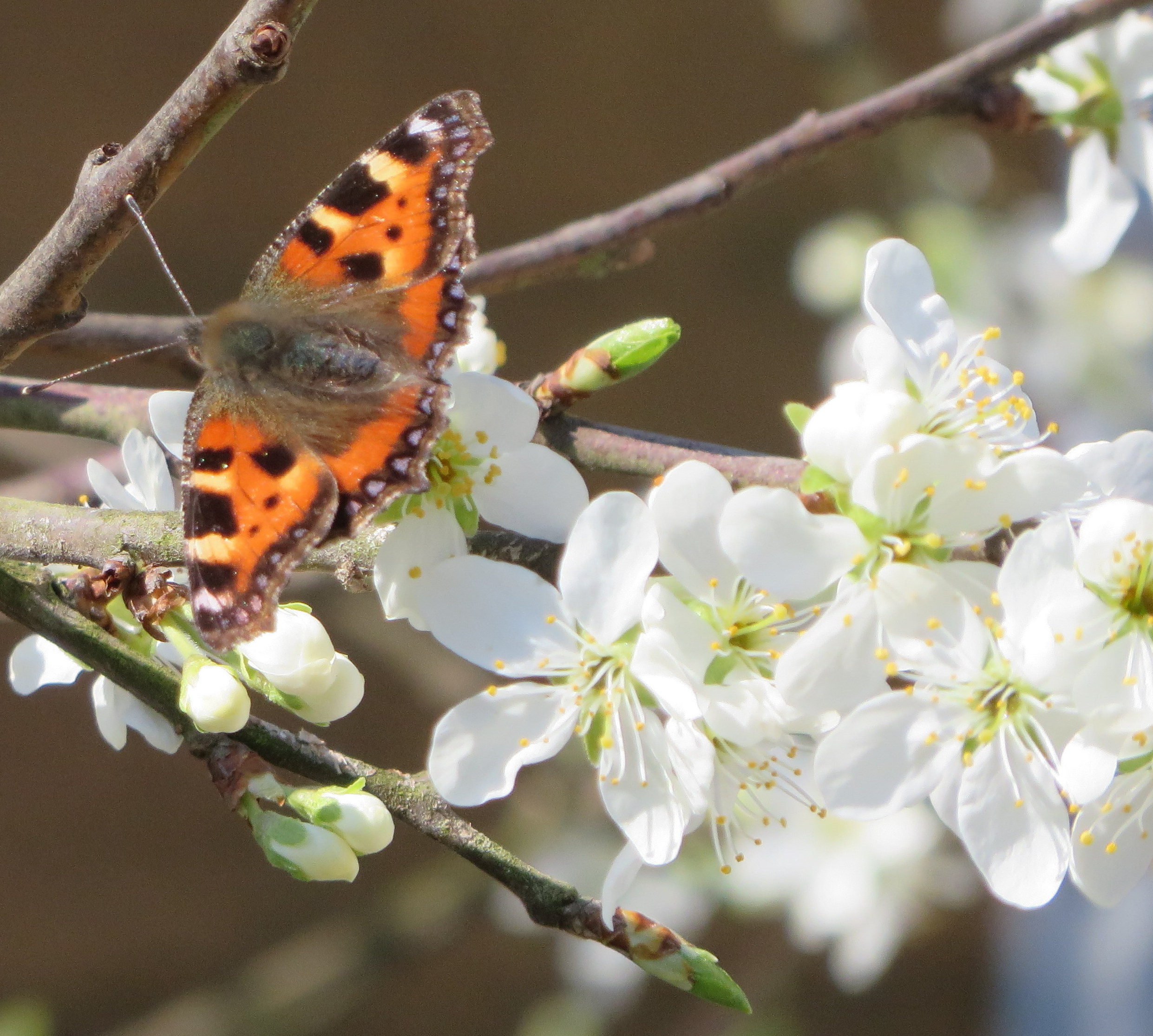
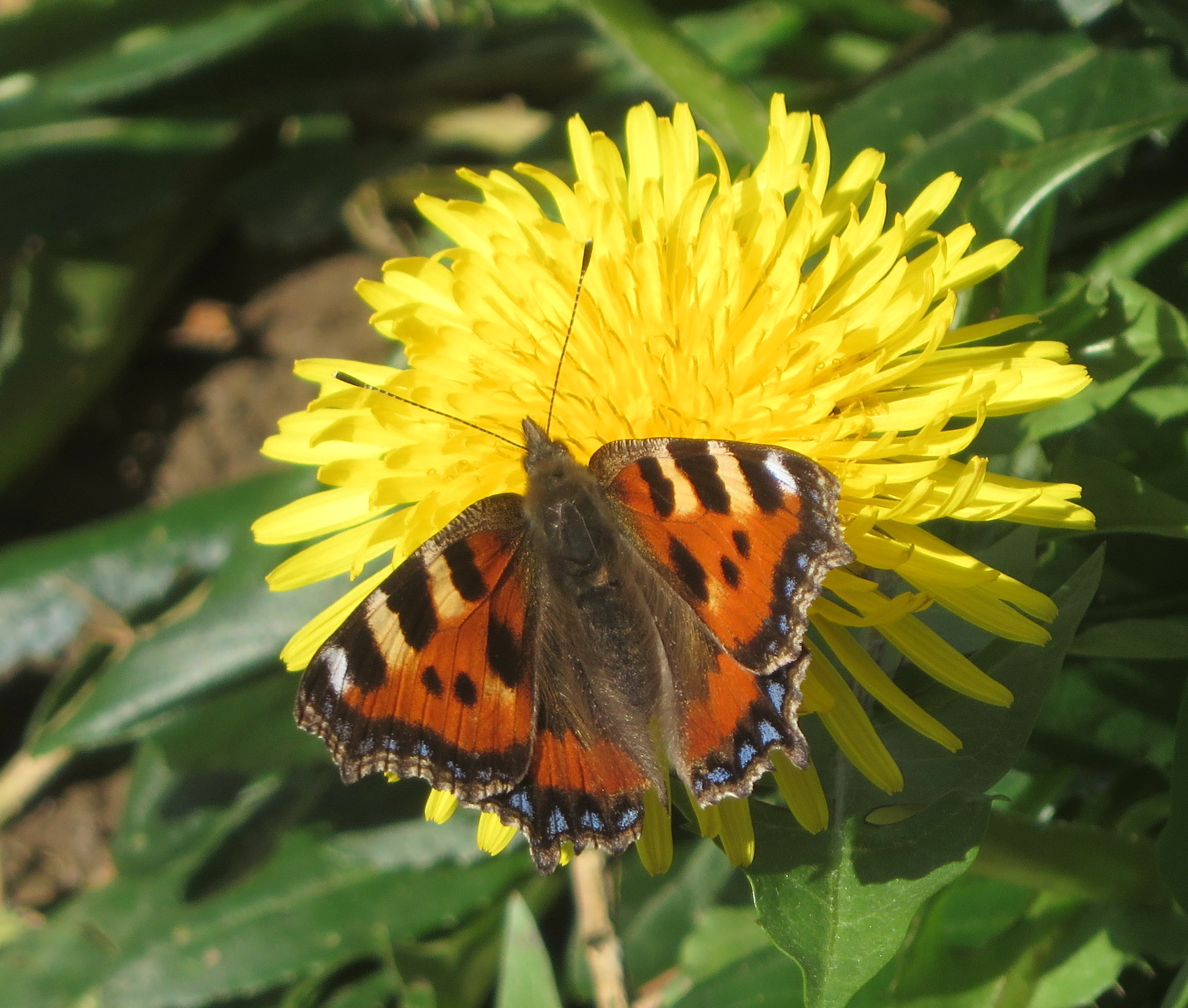
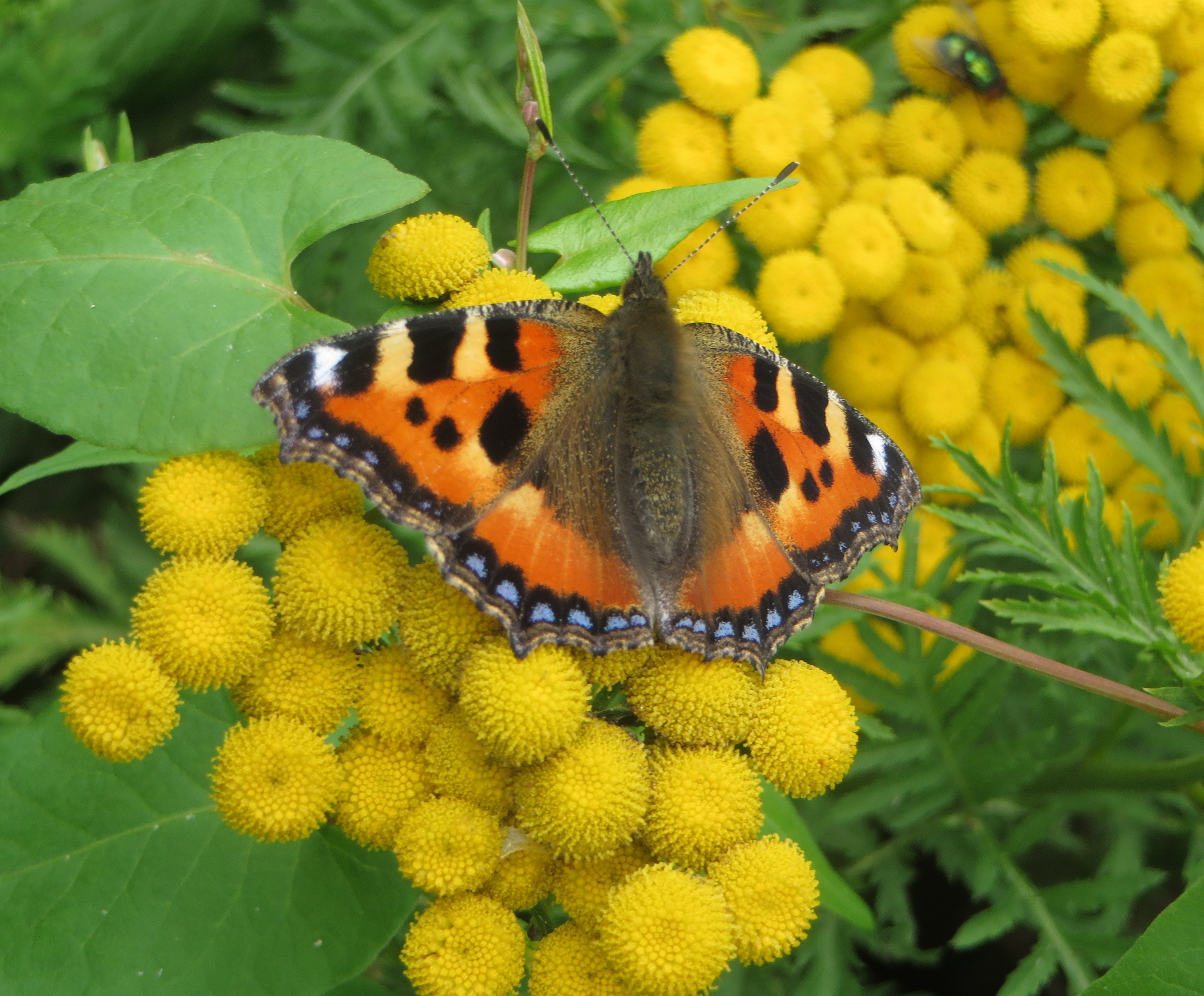
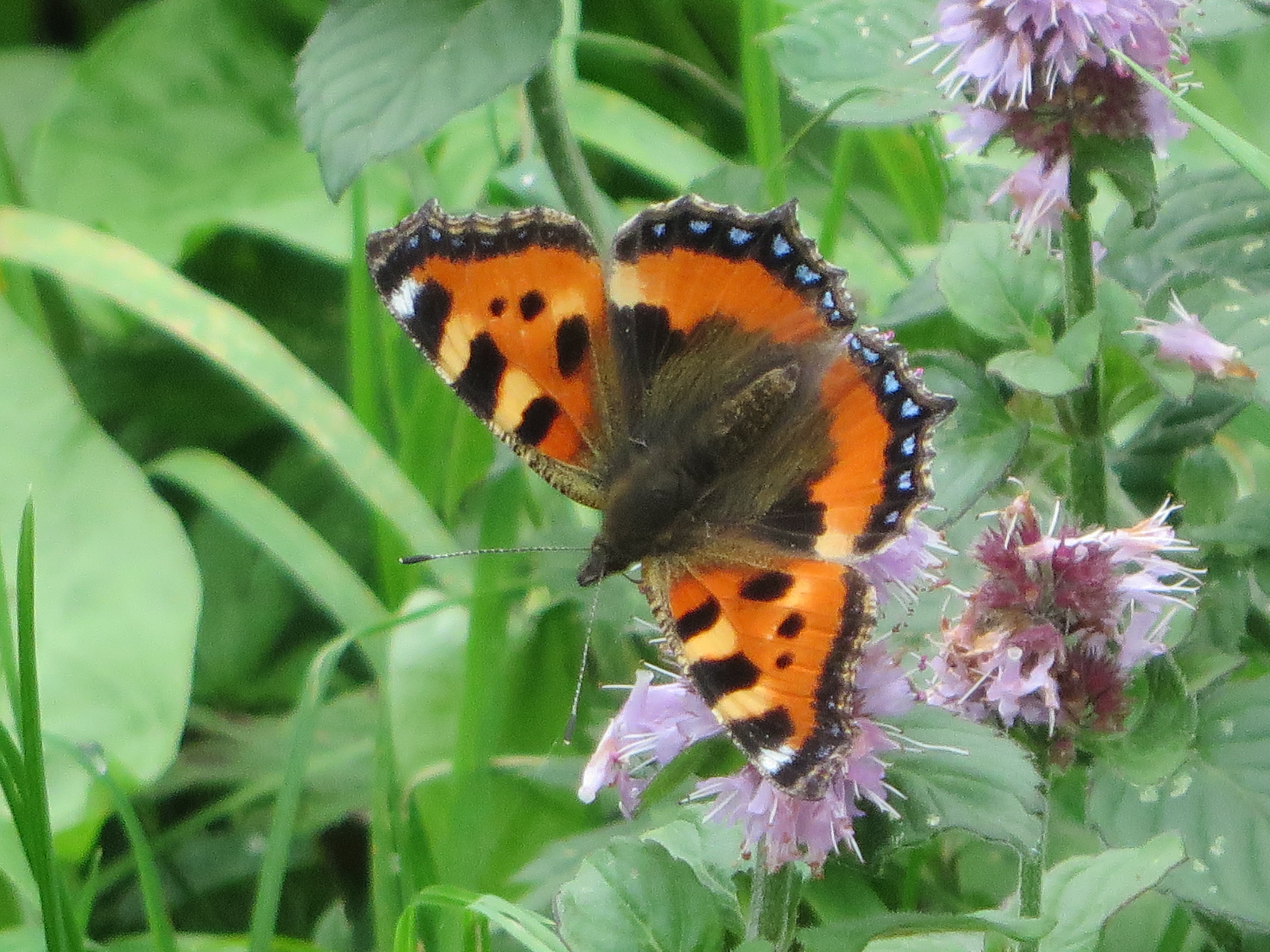
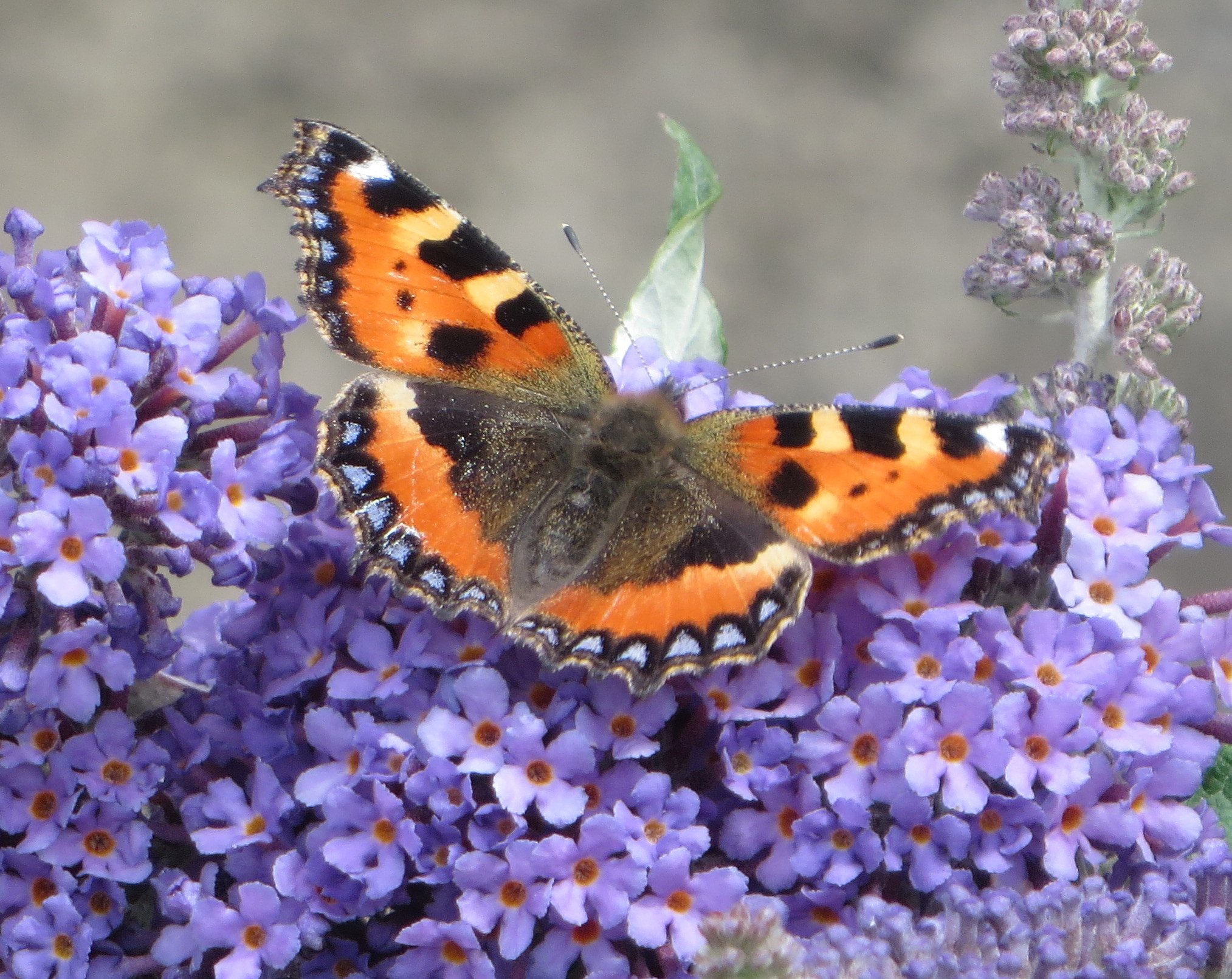
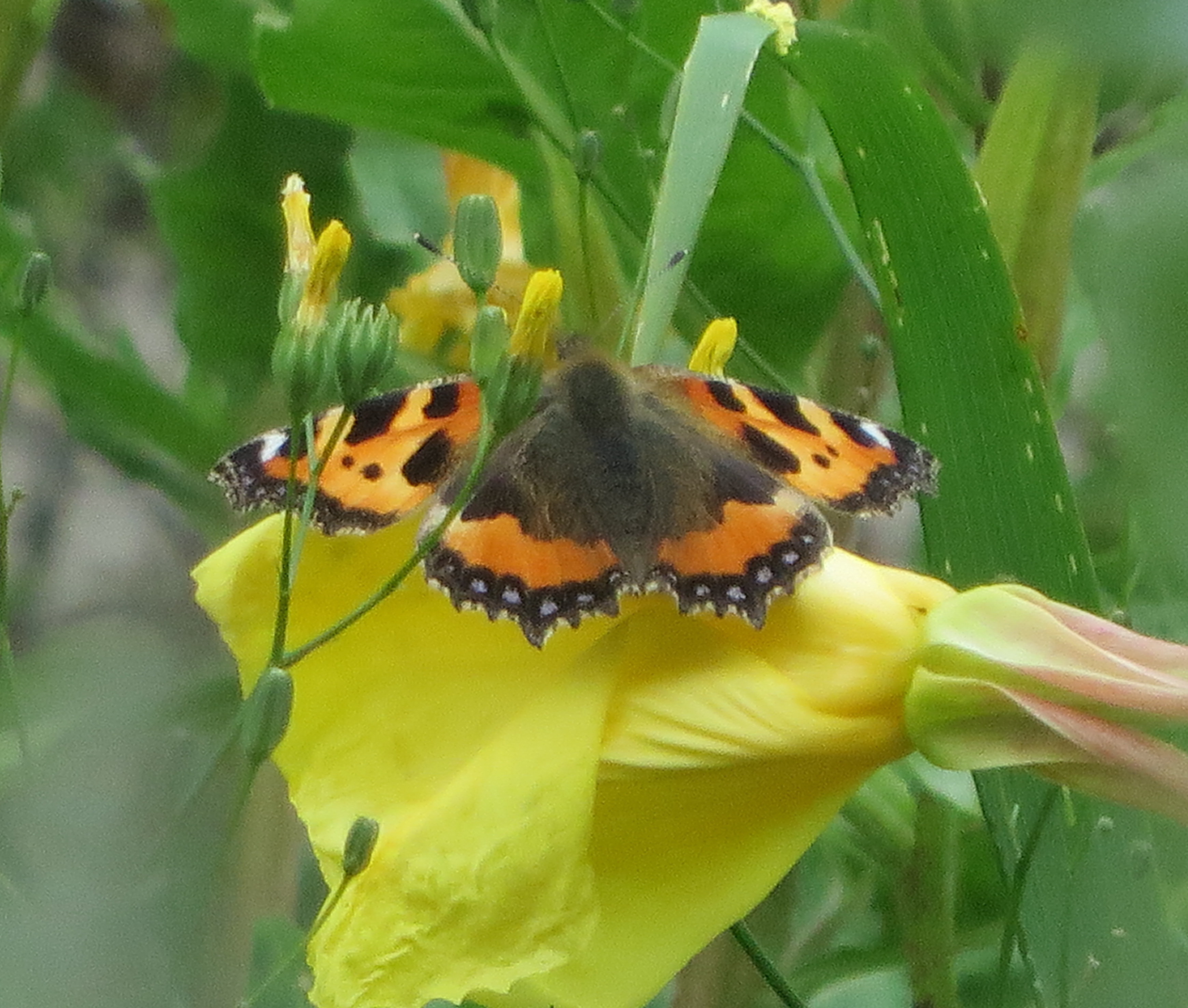
Light winds and bright spring sunshine and air temperatures hovering around the magic 12 Celsius, the minimum needed for butterflies to fly meant we had to get out and explore. And we did!
Pat Bell, while penning an email about butterflies was distracted by a movement outside. A lovely Peacock had alighted on his wall, absorbing heat from the masonry-his first butterfly and his first garden butterfly of 2020.
Frank Smyth, who often observes butterflies around the scenic Howth area, saw two Small Tortoiseshells and two Peacocks, despite the breeze locally. When it is windy during marginal temperatures, butterflies usually stay low, bask frequently and take to sheltered hollows.
For Mother’s Day, I brought my mum to Lullybeg, County Kildare. Passing through Lullymore, we saw two lovely golden Brimstone butterflies from the car, our first butterflies of 2020. Folklore from Scandinavia has it that if the first butterfly seen in spring is yellow, a great summer follows. I am tempted to believe that now, although the Brimstone was not the very first butterfly recorded in Ireland this year.
In Lullybeg, we counted 10 Brimstones, among them two females. The males were scouring brambles and Common Ivy, seeking females. They make a lovely sight in spring, flashing deep yellow in the clean spring light. We got four Peacocks too all in one sheltered dip in the ground.
Michael Gray got his first butterfly of the year too-also a Peacock (Dublin mountains) but it was so tattered that it couldn’t fly. Strange as it seems so early in the season, this does happen. Peacocks spend the winter as adult butterflies, having fed heavily during the previous summer. During the pre-over-wintering feeding phase, many get tattered from bird attacks and even though they survive the winter, wing damage is, alas, irreparable. No such issue in the midlands; Dave McKay reported Peacocks flying in the sunshine in the Athlone area.
Another species that over-winters as an adult and that made its spring debut yesterday was the Comma butterfly, reported by Kilian Mullett from Clara Vale Nature Reserve, County Wicklow. Check warm, sunny glades in woodland, especially where there is Grey Willow in bloom-this is a Comma favourite.
In Ireland’s northwest, David McIlveen reported a Small Tortoiseshell from Letterkenny. Donegal is an amazing county for butterflies; very wild and often unspoiled, its sheltered spots can produce very early records-much earlier than one might expect given its location!
Not all butterfly lovers saw butterflies yesterday. From Cavan, Jonathan Shackleton reported Chiffchaff singing, his first Sand Martin and Great Crested Grebes performing their spring courtship display this week but no butterflies yet-perhaps being further north and inland has kept them under wraps!
Happily, the next three days will see settled weather and rising temperatures away from the west coast so check your gardens, local patch and report your sightings to us. Please observe physical distancing guidelines. Butterflying is a healthy, happy lifestyle but we need to take care of ourselves and everyone else.
Enjoy your day!
 Coltsfoot glowing in the sun. This is a familiar sight in spring on disturbed soils. Photo J.Harding
Coltsfoot glowing in the sun. This is a familiar sight in spring on disturbed soils. Photo J.Harding
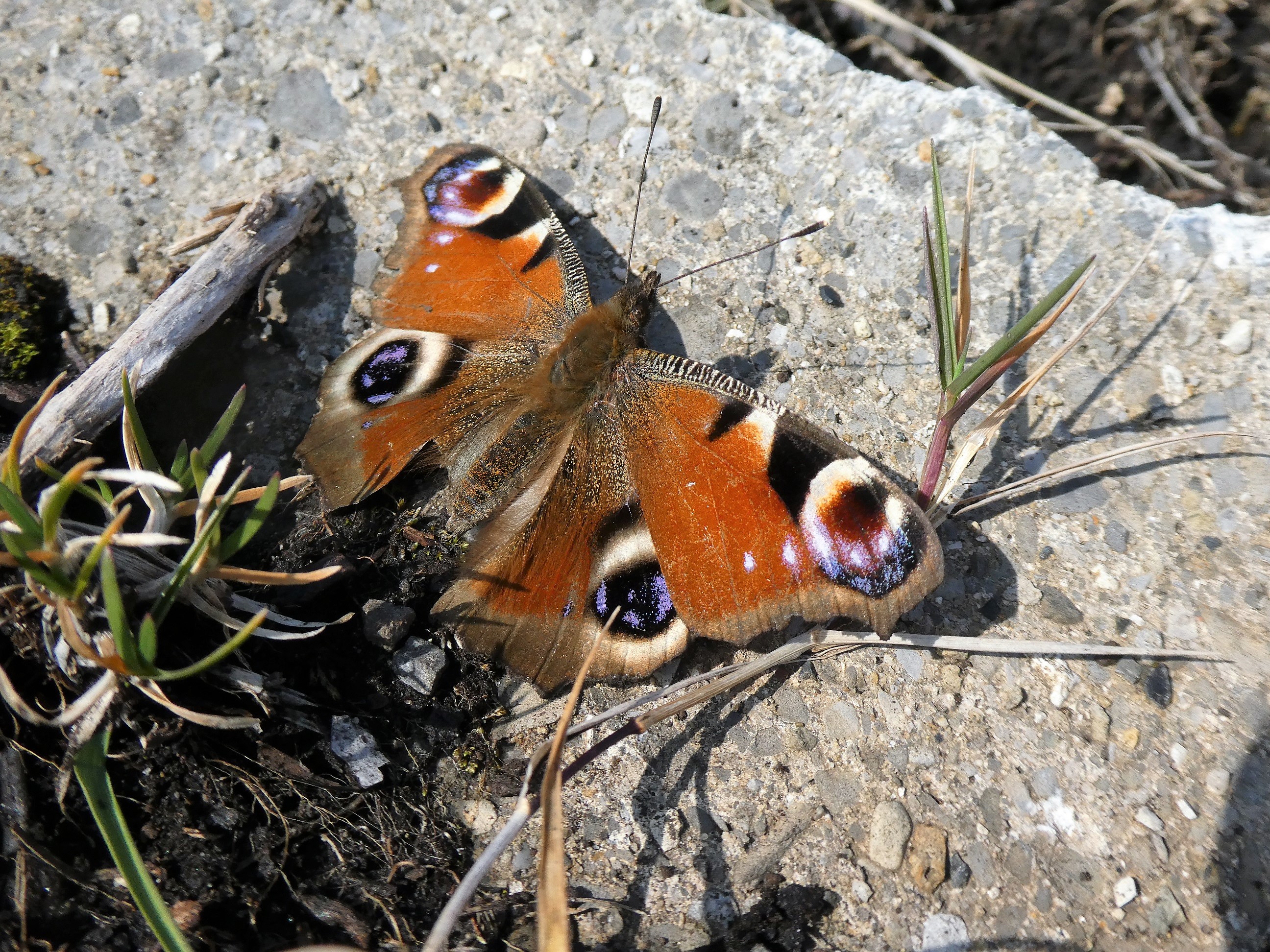
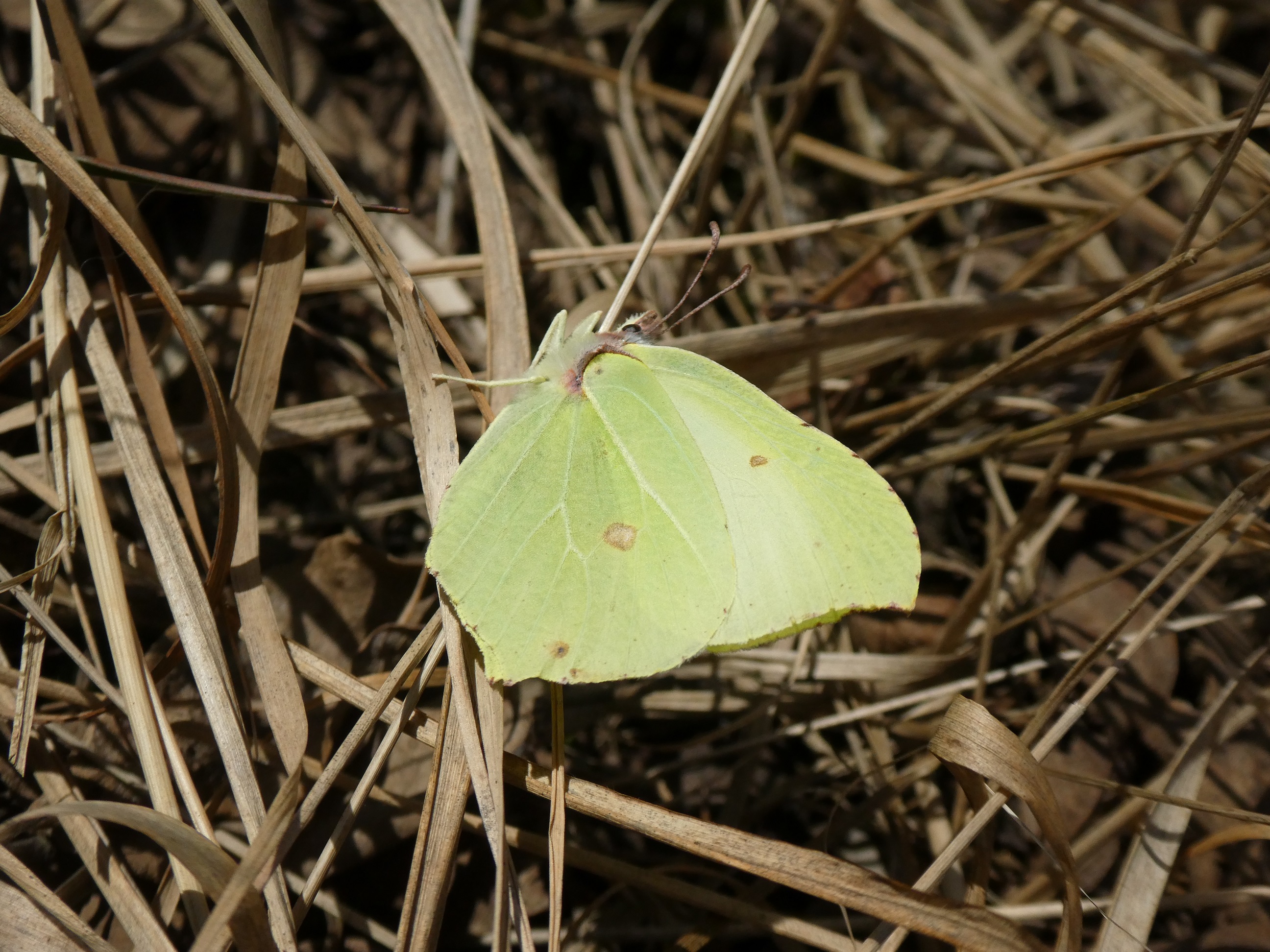



Spring is here. The pubs and restaurants are shut for humans but you can organise a butterfly banquet if you get your garden ready now.
To attract butterflies to breed in your garden, you need to grow the plants that the caterpillars feed on. These are native plants and you can read about the plants needed in our gardening for butterflies leaflet here:
https://butterflyconservation.ie/wp/wp-content/uploads/2017/12/BCI-Garden-leaflet.pdf
The theme of this post is to advise on a set-piece planting arrangement for adult butterflies to provide nectar throughout the season. Nectar is basically the same wherever in the world it comes from, be it China, Australia or Ireland. The adults do not care-nectar is nectar. The caterpillars do need native plants to feed on so natives will be your staple! For adults, though, we can break the natives only rule.
As for the adults, we suggest you think of aspect first. A border planted in front of a south-facing hedge or wall will be ideal-butterflies rarely feed on shaded flowers. Your taller planting should be at the back of the border, graduating to the lower-growing plants at the front.
We suggest two buddleia species for the back of the border; Buddleia davidii and Buddleia globosa. The first, Buddleia davidii has long spikes of purple-pink flowers packed with nectar. Native to China, it is a terrific draw when it blooms from late July when it can be packed with butterflies. It can grow to 5 metres but can be pruned severely to control it. Buddleia globosa, native to Chile contains balls of orange flowers. I have seen this plant flower in June and September; if you can, get one that blooms in September when many more butterflies visit gardens. Again, this plant can be easily pruned.
In front of the buddleias, hebes can be planted. These can reach a metre in height, depending on species. I like Hebe veronica, a purple-flowering fleshy-leaved evergreen that reaches about a metre and a half. Again, butterflies are obsessed with its nectar. This plant is vulnerable to extreme frosts but the plant is easily propagated from softwood cuttings inserted in a jar of water placed on a window board out of the direct sun.
Another great plant for your border is the lavender native to the Mediterranean region (southern France, Italy, Croatia), Lavandula angustifolia. This aromatic shrub reaches about 1-2 metres. Its purple blooms are beloved by bees, Small Tortoiseshell and Small and Large Whites especially. It needs dry soil-it will not do well in heavy, wet soils.
A tall native flower that can be planted among the hebe and lavender is Hemp Agrimony, eupatorium cannabinum. This tall perennial likes wet soil and has frothy pink flower clusters. It attracts just about any butterfly that flies during its flowering time, July-September.
Lower down in the border, and a later-flowering species are Michaelmas daisies-go for a tall variety. Aster amellus, native to the Alps in Italy and elsewhere, can reach 50 cm. This favours drier, calcareous soils. It can flower into October, vital for late Red Admirals and Small Tortoiseshells.
Two flowers whose height makes it a good companion forthe Michaelmas daisy A. amellus are two native perennials, Common Fleabane Pulicaria dysenterica (see photo) and Field Scabious Knautia arvensis. Fleabane likes damper soils and grows up to a metre. Its yellow flowers appear mainly in August and resemble miniature sunflowers. It is irresistible to Small Copper butterflies; gleaming copper on gold is just delightful-get your camera ready!
Field Scabious flowers in July, August and September. It has pale lilac flowers (see photo). This plant must have dry soil. Bees especially love this beautiful flower.
Towards the front of your border, the variety of plants available becomes greater. The native Common Marjoram Origanum vulgare is a must. It enjoys dry soils but it is less fussy in this regard than Field Scabious. It does desire calcareous (limy) soil. Its flowering peak is mid-summer. I have seen it greatly sought after by bees and a range of summer butterflies. This herb can be used to flavour your food-another reason I love it-it is lovely in pasta sauce.
Ice Plant Hylotelephium spectabile (formerly called Sedum spectabile) is a perennial species of flowering plant in the stonecrop family Crassulaceae, native to China and Korea. This reaches about 45 cm and has a broad, flat pink inflorescence. It flowers mainly in September and is comparable with buddleia in attracting the Vanessids, especially the Small Tortoiseshell and Comma. Again it needs dry soils.
Finally, lower-growing plants for the front of the border include Bugle Ajuga reptans (native, flowers June), Aubretia Aubrieta deltoidea, Arabis species and Sweet Rocket Hesperis matronalis (this is invasive, don’t let it escape into the wild). The latter three flowers bloom in spring.
This list is not exhaustive. If you are in your local garden centre and you see a plant greatly favoured by bees and butterflies, buy it. Happy planting!
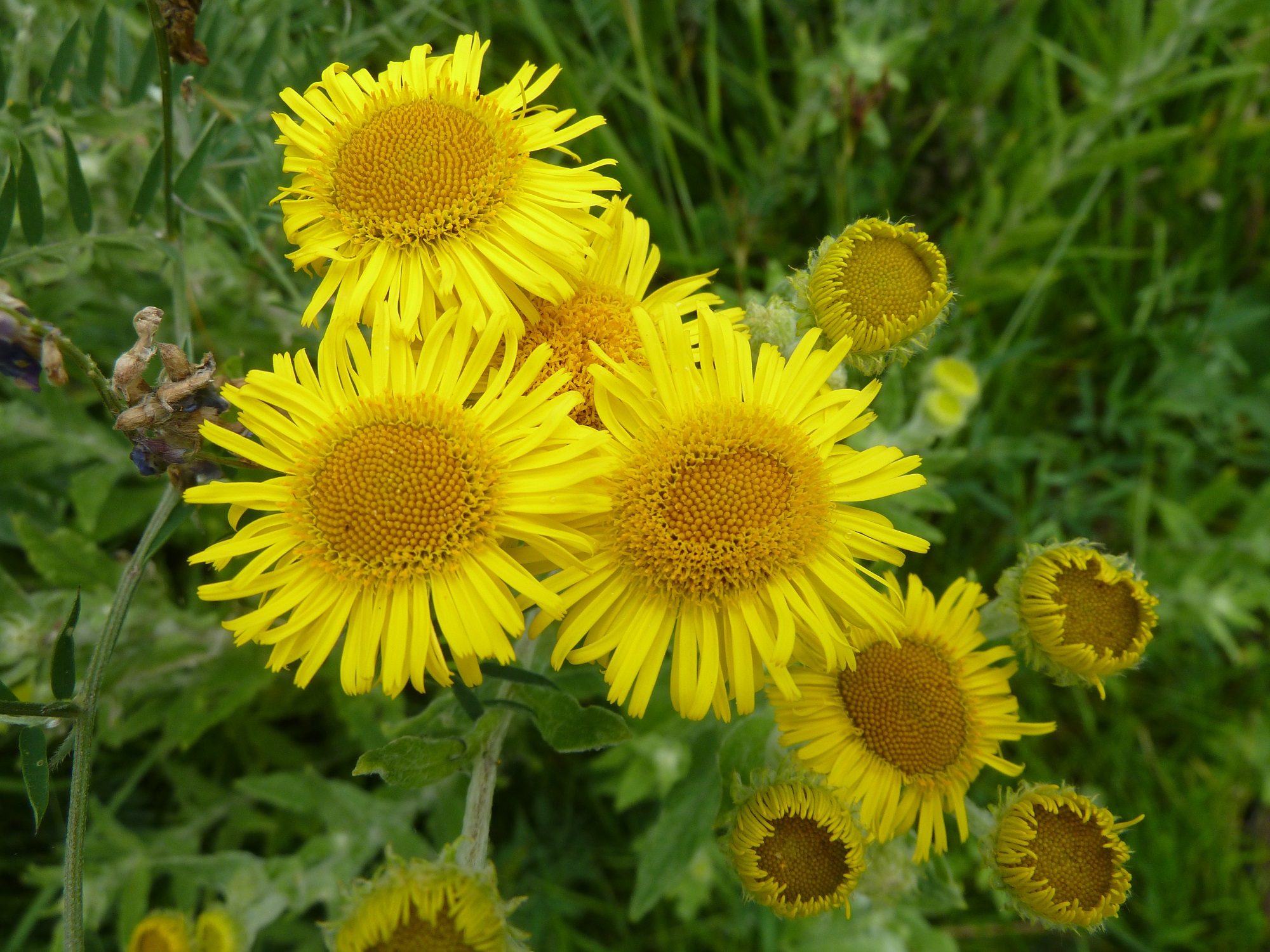
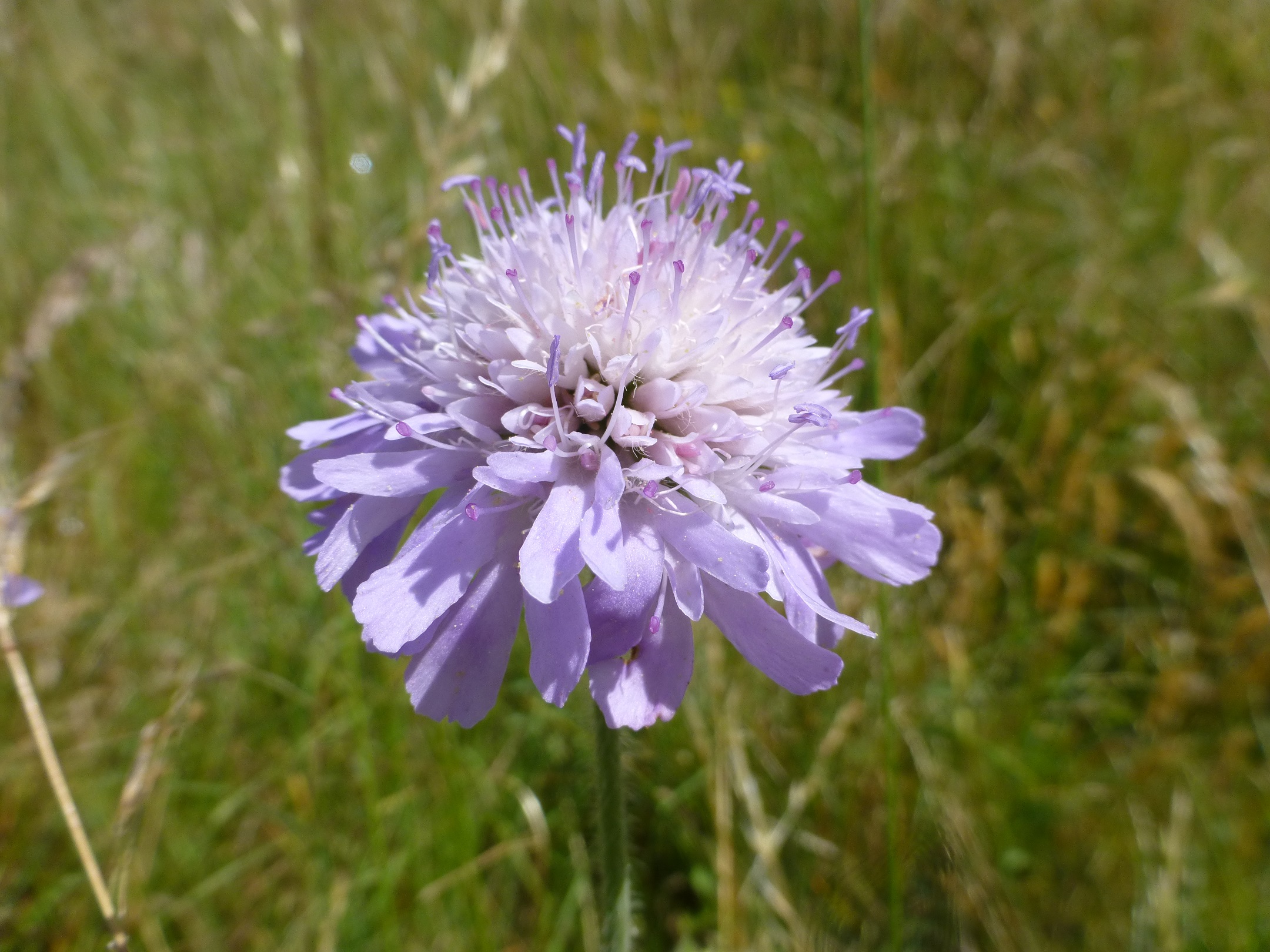
Butterfly Conservation Ireland is well supported by its members who contribute their time, annual subscription and example to the conservation cause. Many members have turned their gardens into nature reserves for butterflies, moths, a range of pollinators, birds, amphibians and mammals.
But there is more that can be done. What about the world beyond the garden? Many species cannot thrive in an isolated patch and need to move to find food, territory and mates.
Many of us live in estates with large green spaces. Indeed, in modern estates, many houses lack front gardens. Space is in public areas instead.
One way to extend butterfly-rich habitat is to look at the often very bland green spaces. A good approach is to link in with with the local Tidy Towns or residents’ association. Some years ago, I did this in my estate in Wicklow. I joined the committee of the residents’ association and put forward the idea of improving the green areas for nature. Happily, everyone agreed. We bought native trees and planted them throughout the estate. We choose planting sites carefully; we avoided planting on the centres of the large central green so children could still play football. We planted Grey Willow and birches on the dampest areas and Rowan on the drier areas. We also planted nectar-rich shrubs like buddleia which are a great hit because people can see the butterflies on them. To this day, the estate still looks great! One very vital step we took was to persuade the builder to spend his landscaping budget on native trees. We provided a list and Silver Birch and native oaks were planted.
When looking at a site, first check what is already there. Can it be improved? What should be retained? Can a belt of native woodland be planted? Only native trees should be planted. There is no real benefit to planting tree species that do not belong in the ecosystem in Ireland. Common Hazel, Common Holly, Rowan, Silver Birch, Downy Birch and Guelder Rose (see photos) are all useful. If there is room, plant some native oak. A ‘butterfly shrubbery’ that is in full sun can really work too. See if an area of grassland can be converted into a wildflower meadow. This initiative will usually find favour if a sign is erected to announce the conservation enhancement being made and if the meadow contains attractive species like Ox-eye Daisy, Marjoram and Common Knapweed. For sources of plants, see links below. The best option, however, is to source tree seed and plants from certified native source Irish provenance. You can even grow your own trees and wildflowers from seed sown fresh!
Butterfly Conservation Ireland has given a number of project planners advice. If you have a project that you would like to help with, let us know. Contact us by email at conservation.butterfly@gmail.com
Flower seed can be obtained from Design By Nature; see http://www.wildflowers.ie/
Native trees can be obtained from Future Forests; see https://futureforests.ie/
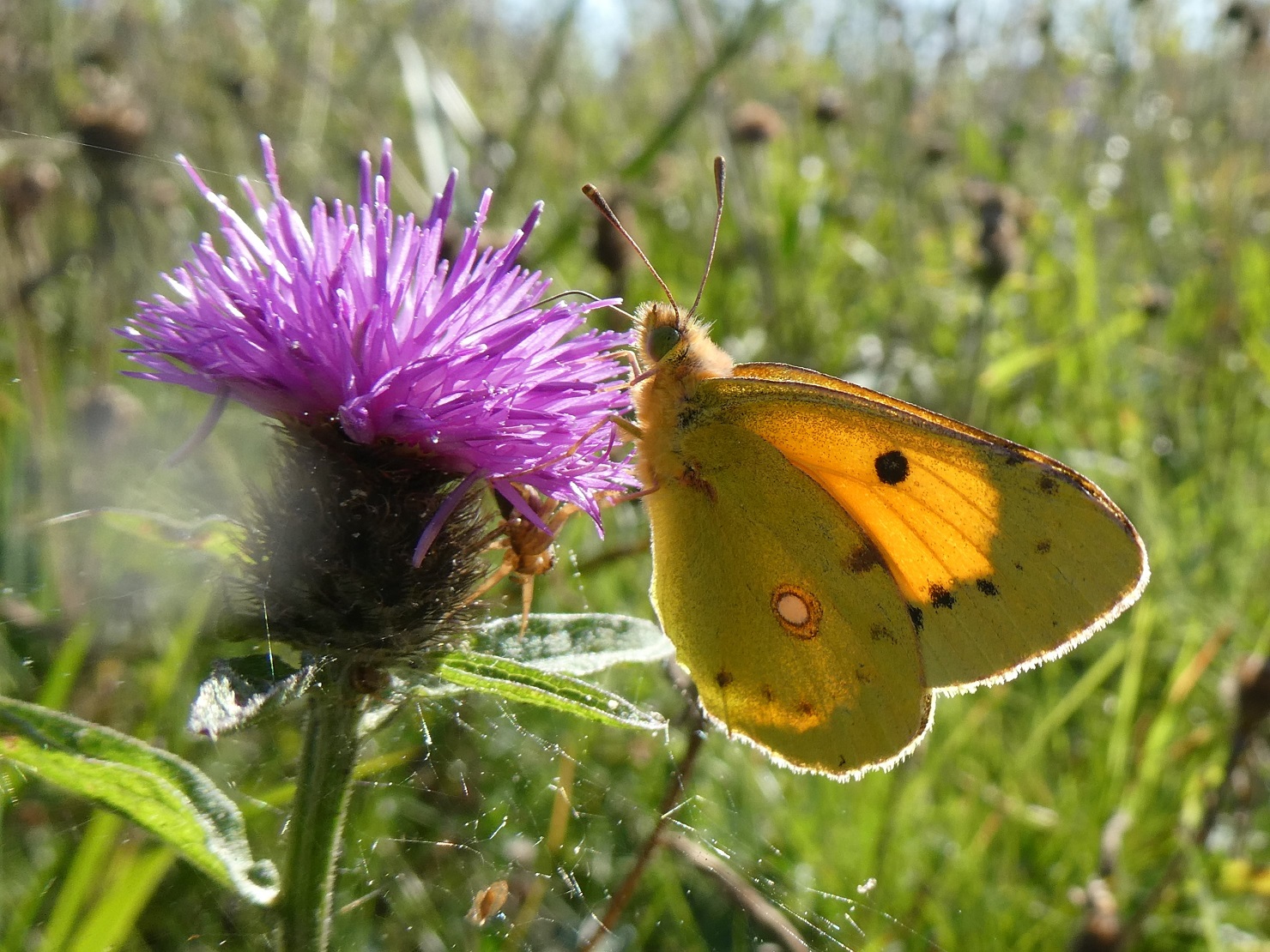
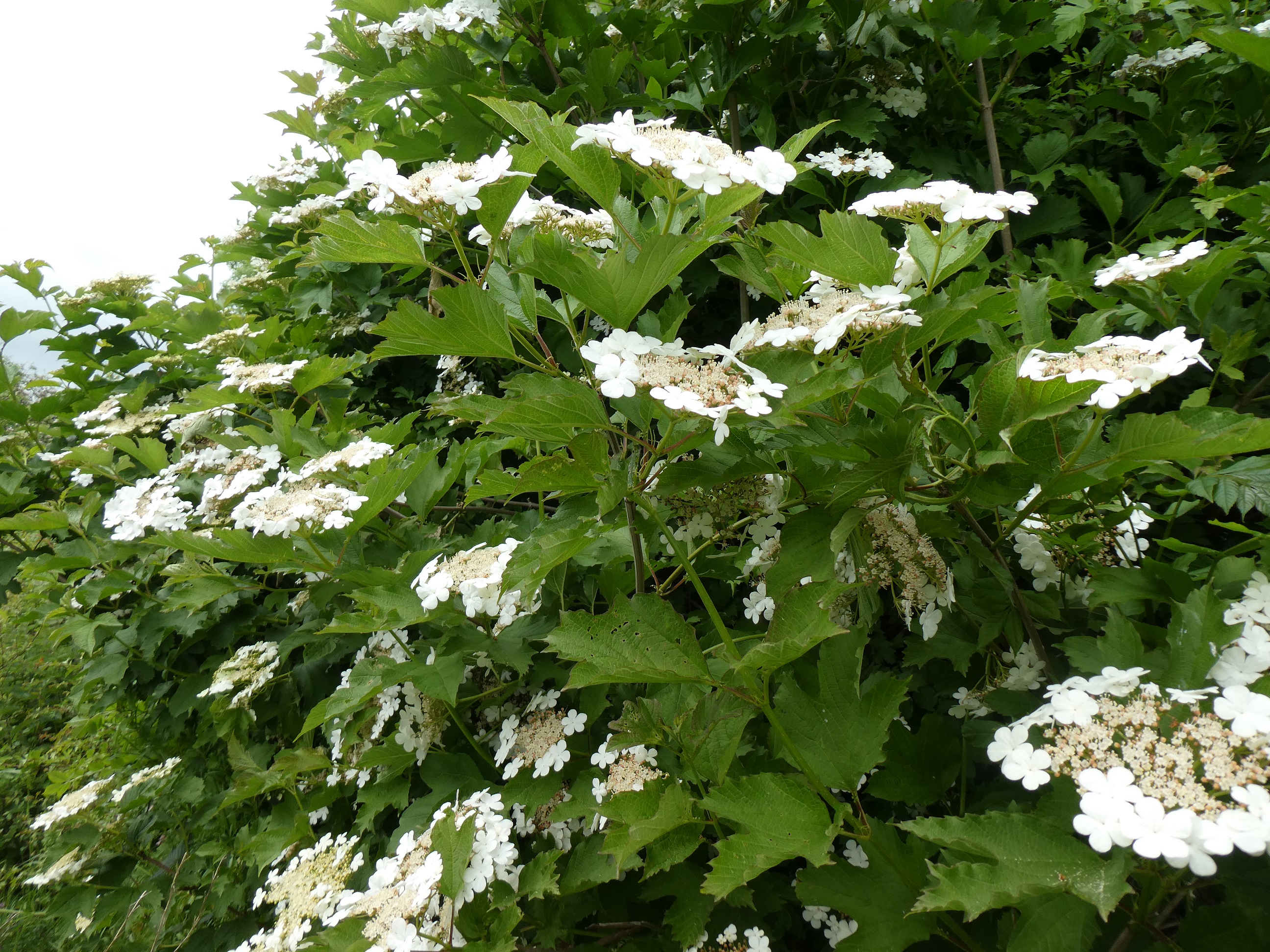


The track leading to the Irish Peatland Conservation Council’s important butterfly reserve at Lullymore is a phenomenal draw for butterflies. At the season’s peak in July and August, there are days when hundreds of butterflies flock to the nectar packed into sow thistles, trefoils, vetches, Devil’s-bit Scabious, Common Knapweed, eyebright and other flowers.
Over the past three years, the track has become shaded by over-hanging willow and birch, encouraging bramble and ivy to invade, crowding out many of the herbs.
The track is so important that intervention was vital. Butterfly Conservation Ireland got involved, especially Pat Wyse who strimmed the entire track length, tackling the dense bramble. Over-hanging branches were cut back and, towards the end of the track, adjacent to the reserve entrance, willow, birch, gorse and broom were cut back; these were a serious hindrance to Common Bird’s-foot-trefoil, much-needed by two very special species, the Dingy Skipper butterfly and Narrow-bordered Bee Hawkmoth which are frequently concentrated here in May.
We have exercised care in trimming back the Grey Willow you see bordering the track to the right. Some of the plants are male; Grey willow is dioecious, meaning male and female flowers grow on separate trees. The catkins arrive in early spring – the male catkins grey, stout and oval, becoming yellow when ripe with pollen; the female catkins longer and green.
The male flowers are greatly sought by bees seeking pollen and also by spring butterflies. Brimstone, Peacock, Small Tortoiseshell and Comma all enjoy this plant’s nectar. What looks bare and lifeless now will soon be greatly favoured. Around 115 of our larger moth species breed on willows. These plants, south-facing, will soon be used for breeding.
And thanks to Pat Wyse, flowers will again bloom here in the weeks and months again. We recommend anyone who loves butterflies to visit this track this summer-you will be dazzled by the sheer numbers on good days.
